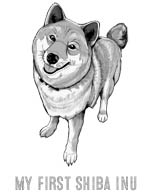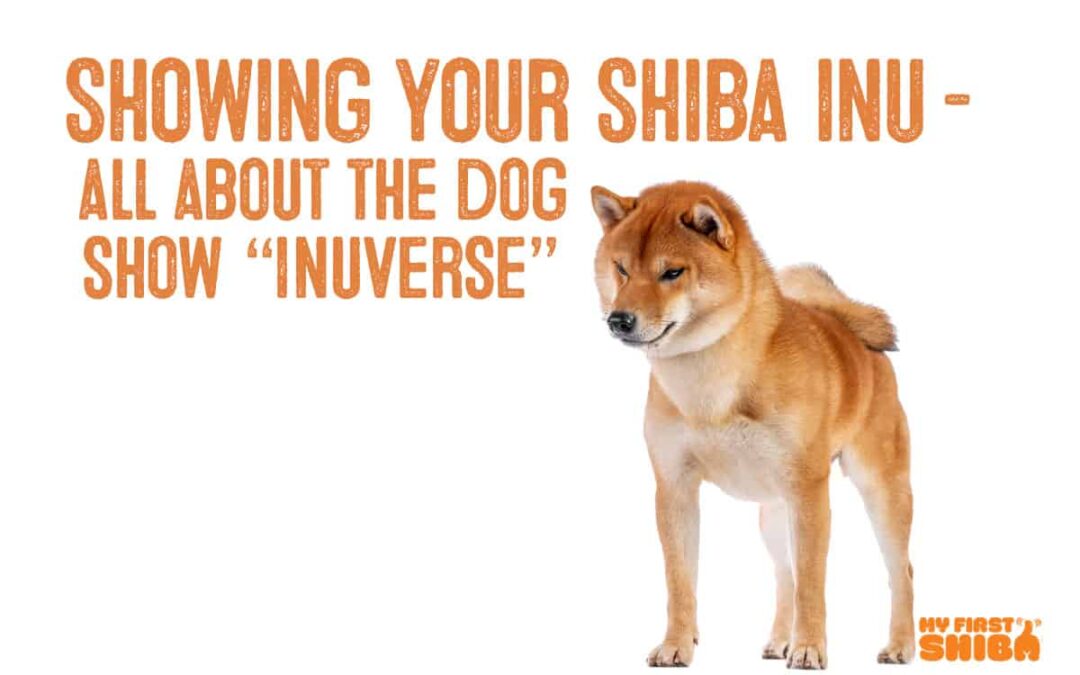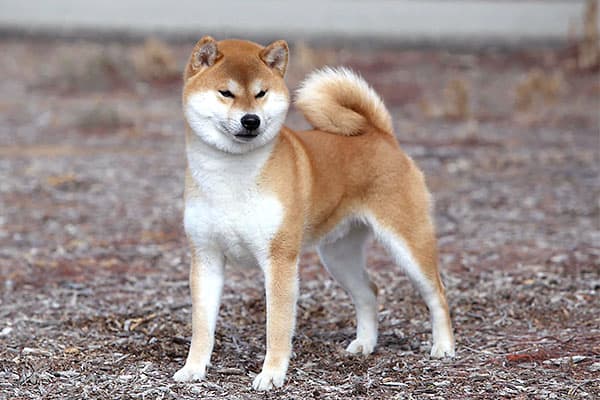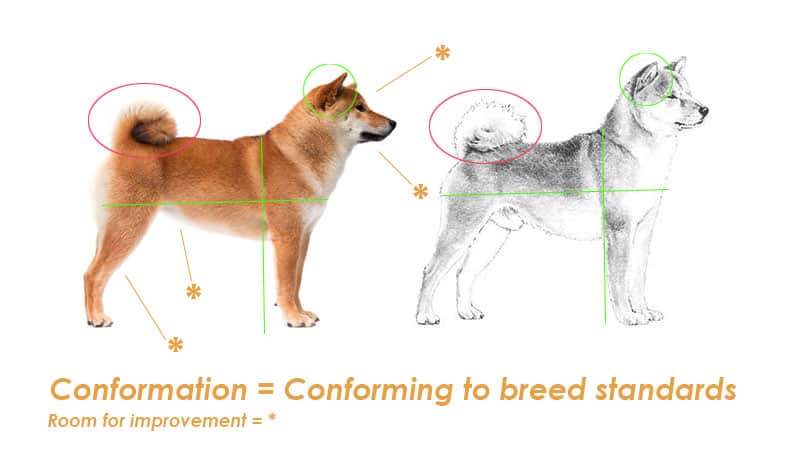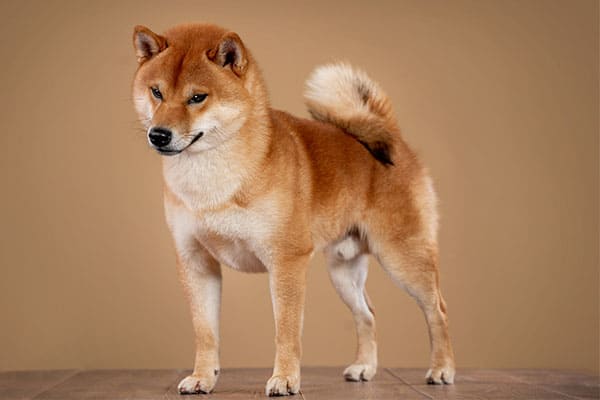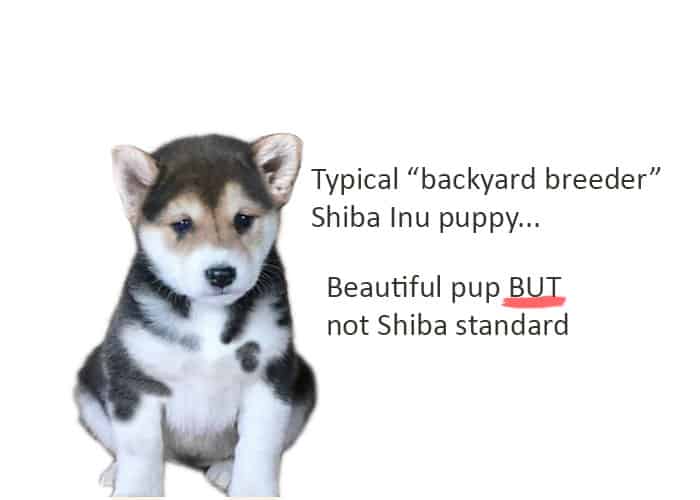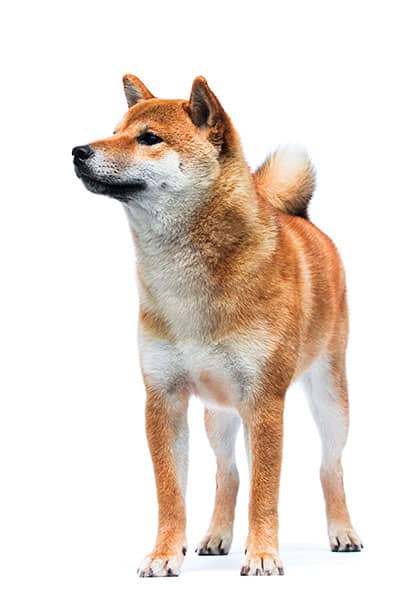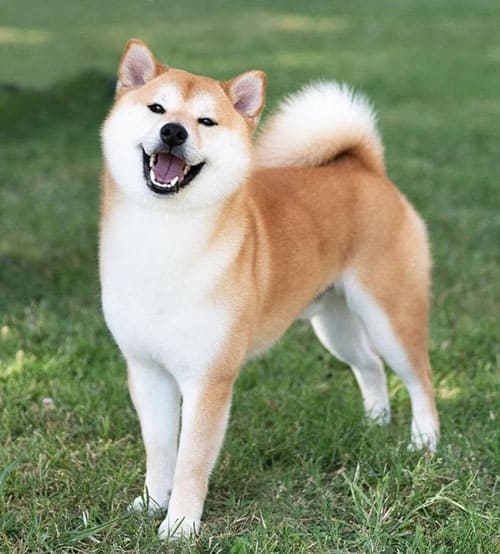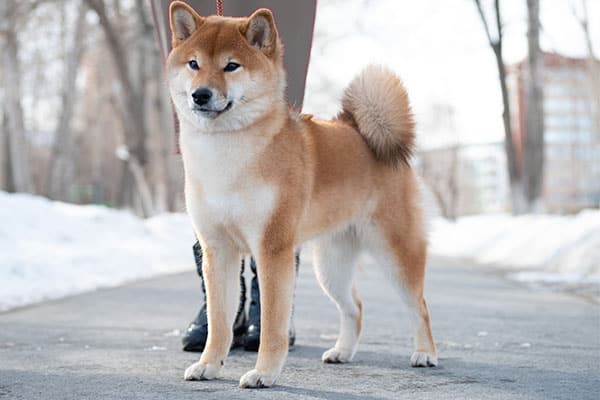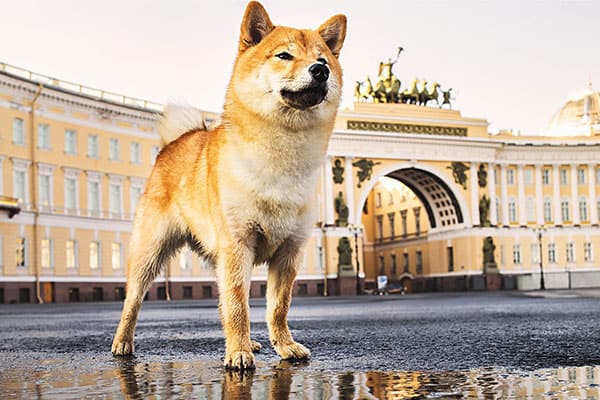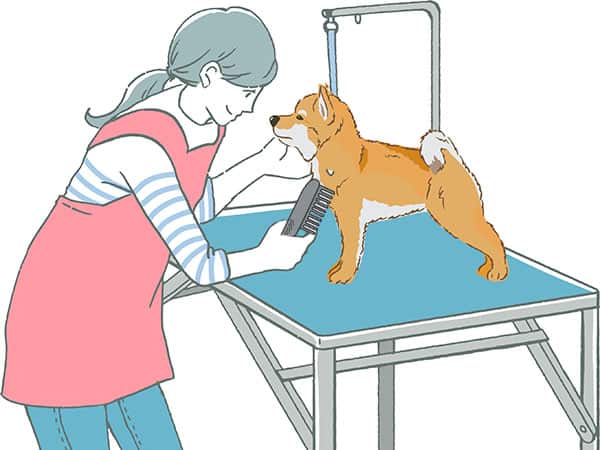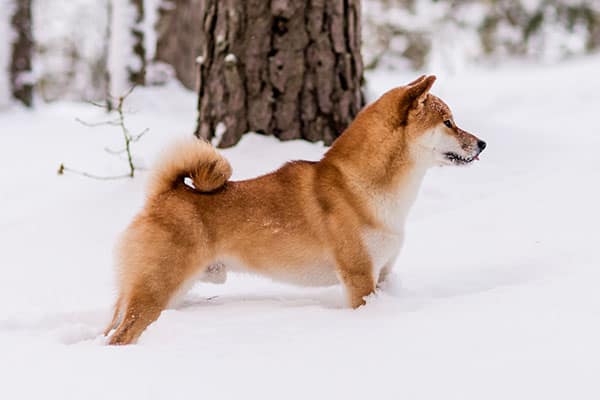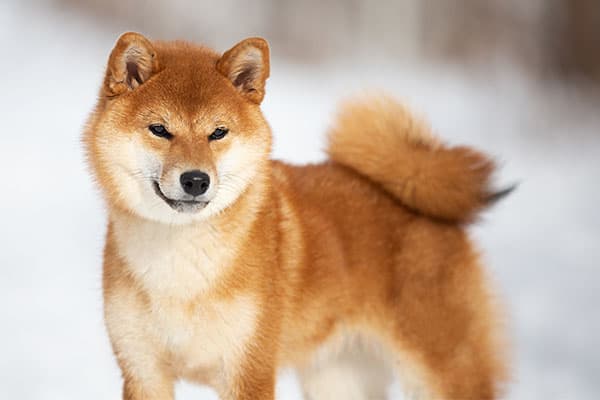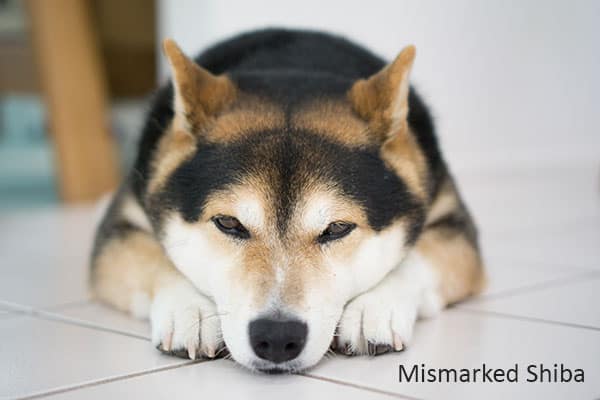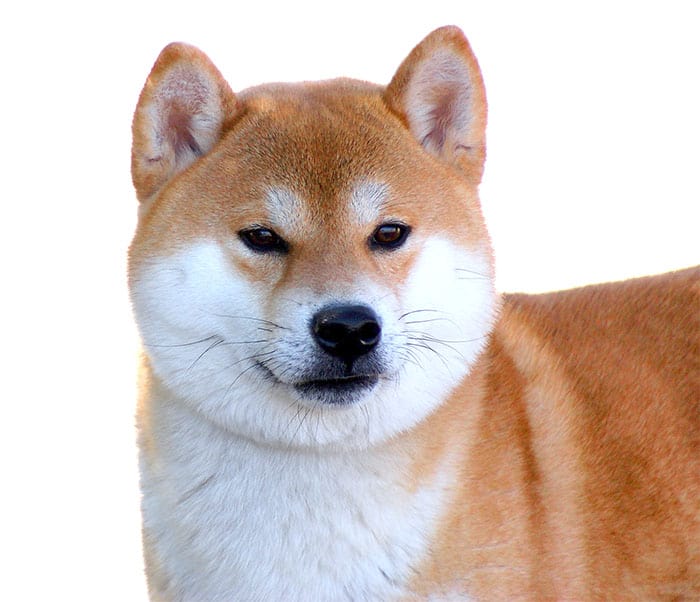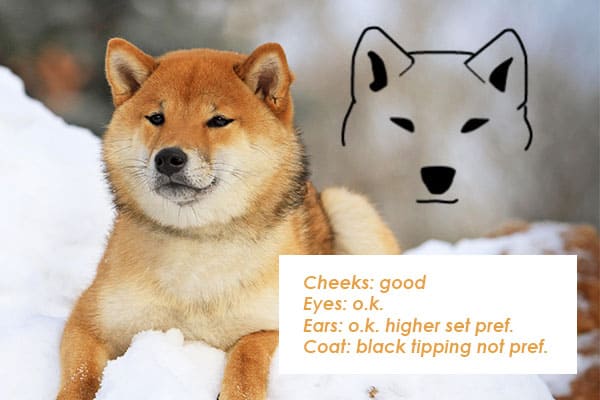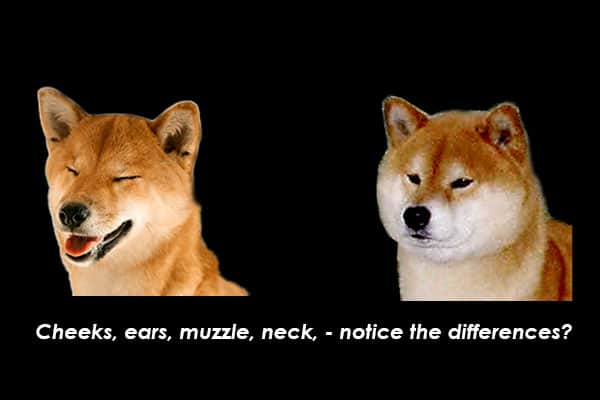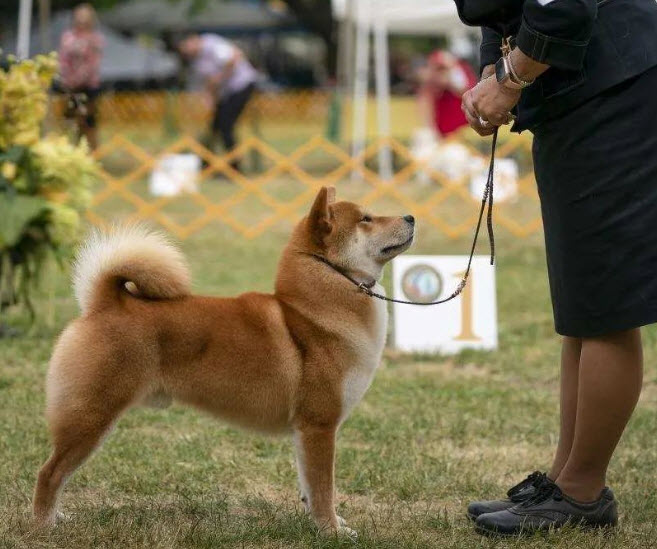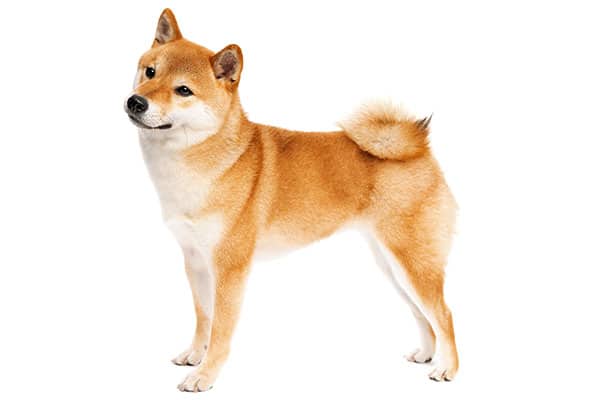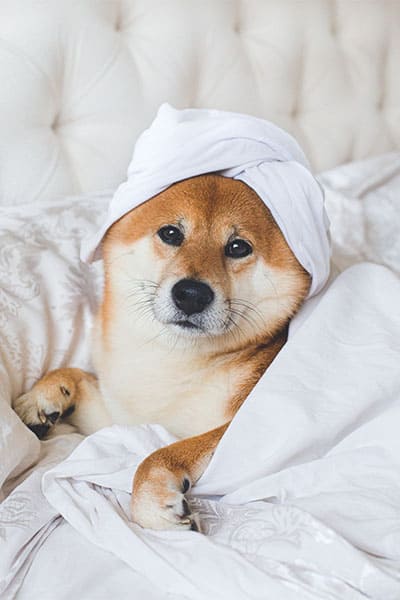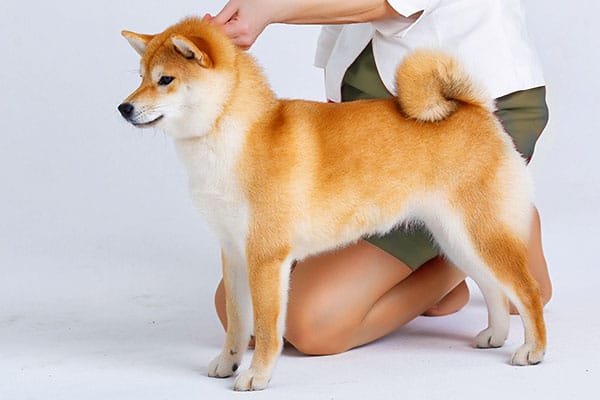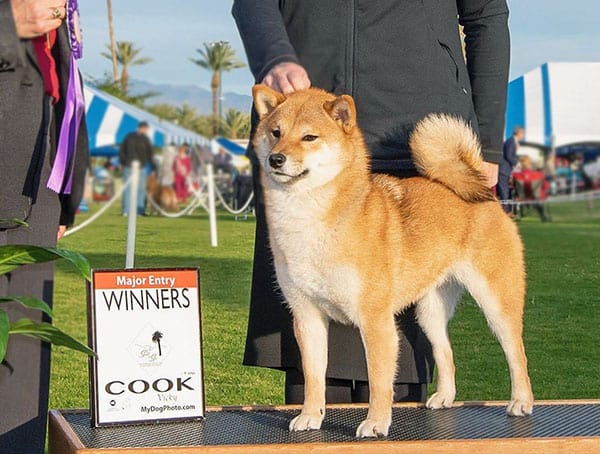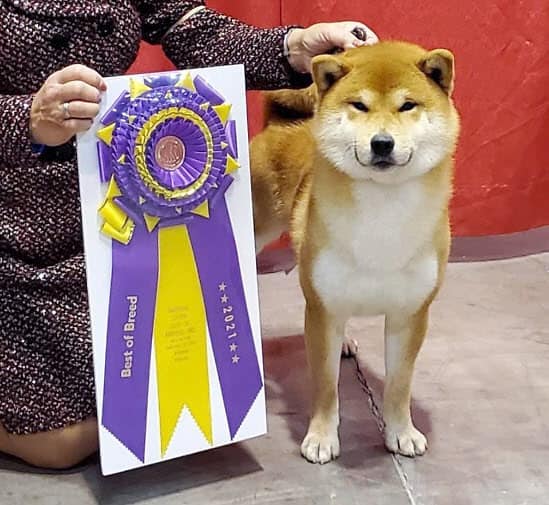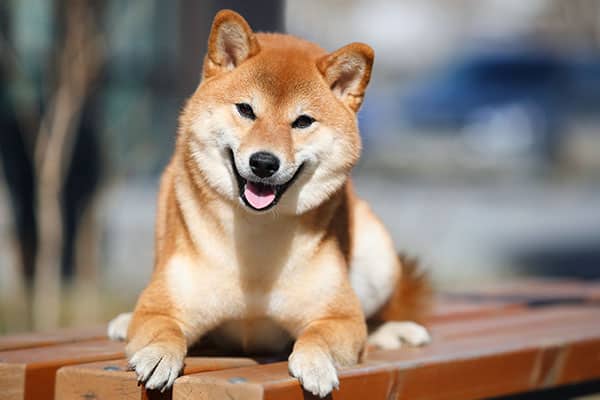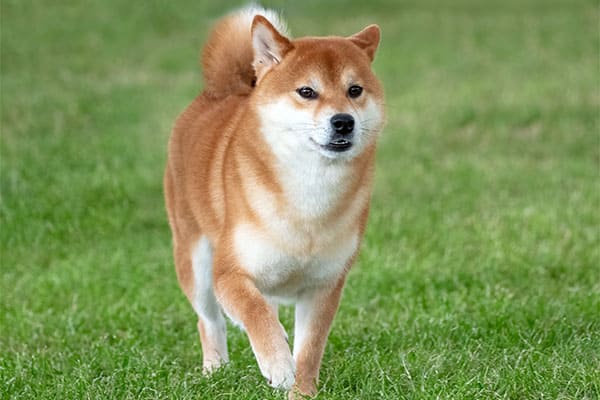On occasion, our posts contain affiliate links. However, we only recommend products that we truly believe in. For more information, visit my privacy policy page.
Phew, this website is a labor of love and largely a one-woman show so unless indicated, all articles written by J.Tsukamoto
Tremendous thanks to Yumi Hagiwara of Nippo Hauoli Shibas and Susanne Ozasa of Jogoso Shiba Inus for their help and contributions to this article.
Shiba Inus are one of the most beautiful breeds of dog we are fortunate enough to admire.
Retaining that natural beauty requires the continued efforts of preservation breeders devoted to maintaining standards along their bloodlines.
Showing their dogs is one of the tools that breeders employ to help them evaluate their breeding stock.
It’s also an invaluable way to connect with other preservation breeders who share the same goals.
If you have a Shiba Inu that is of “show” quality, showing your Shiba whether you plan to breed or not is a great way to educate the general public about what the Shiba Inu breed should look like.
Gorgeous Shiba Inu From Nippo Hauoli Shiba Inu and master breeder Yumi Hagiwara
It’s also helpful in teaching new Shiba Inu owner hopefuls the importance of distinguishing properly-bred Shiba Inu over ill-bred puppy mill type Shiba Inus.
Reducing the number of ill-bred puppies is a win-win for everyone.
It’s especially beneficial for the dogs suffering in bad breeding conditions, as well as the countless shelter dogs that possibly lose a chance for a new home when a badly-bred puppy is sold instead.
Dog Shows ARE NOT Simply Beauty Pageants
The purpose of dog shows is to evaluate potential breeding dogs to determine which dogs have the best chance of passing on good traits to their offspring.
To determine this, judges score dogs based on how closely they conform to breed standards.
They are not judging dogs against other dogs in the competition.
The only critical criteria that show dogs must strive for is – conformation to breed standards. That’s it.
Reasons To Show Your Shiba Inu
Participating in dog shows is an absolute passion for many dog owners.
It’s a way to bond and work with your dog to achieve meaningful goals together – with the benefits of learning a lot along the way.
Most people in dog shows are truly passionate dog owners that form a community of fellow dog lovers to create a positive environment that enriches both their lives as well as their pampered pooches.
Dog show owners put so much effort into the care and the happiness of their dogs which provides a great model of how we should all care for our beloved family members.
One of the most important reasons for dog shows is to educate others about your breed and raise awareness about the standards of the breed so that future generations flourish.
Because of this, you should only show your Shiba Inu if your Shiba Inu has confirmed show potential.
You would be doing the breed a disservice if you enter your Shiba Inu that is not show material.
The main goal of dog shows is to strive for conformation to breed standards.
This is so future generations of Shiba Inus retain all of their traits that make them special, unique, and most importantly – healthy.
If your Shiba Inu is not an excellent example of the breed standard then it wouldn’t be helpful to the breed, and others, show your dog.
There are many other activities you and your dog can partake in that would likely be more enjoyable for your dog.
Without awareness of breed standards, puppy mills and backyard breeders will continue to breed non-standard and low-quality puppies often stricken with health issues to the unknowing public.
Many unknowing Shiba Inu owners often take offense when they feel that their Shiba Inu is being judged due to their looks that are obviously far from standards.
They feel that others who value conformation are “elitist” or snobby.
In actuality, breed advocates are instead spreading awareness about proper breeding practices and the importance of conformation.
Proper conformation is not only about appearance. Properly conforming Shiba Inus are healthier and happier than ill-breed puppies.
Those that value breeding for standards and bringing awareness to the issue is doing so to help other avoid puppy mills and bad breeders.
In response to social media posts involving breed standards, some Shiba Inu owners often say “Who cares?”, “All dogs should be loved”,
It’s definitely true that all dogs should be loved.
However, the truth ALSO is that ill-bred Shiba Inus likely came from a backyard breeder, or even worse, a puppy mill.
Dogs bred at puppy mills SUFFER. And the resulting puppies from these litters SUFFER as well.
IF… “looks don’t matter, who cares?” – then why purchase a purebred Shiba Inu that likely came from a byb or puppy mill?
Wouldn’t it be better to rescue / adopt versus supporting institutions that promote suffering and animal abuse for profit?
If one truly cares about animal welfare and wanted a Shiba Inu at the same time – wouldn’t it make sense that individual to find a reputable and ethical breeder of a Shiba Inu to ensure that their purchase is not enabling suffering?
That’d be the most responsible and compasionate thing to do.
Dog Shows Help To Ensure a Good Breeding Future
Because the main purpose of dog shows is to evaluate breeding stock, most participants in dog shows are dog breeders and breed-specific fanciers.
Due to the amount of effort, resources, and time it takes to participate in dog shows, it’s important to first determine your reasons for showing your Shiba Inu and if your Shiba Inu is show-worthy.
You don’t have to be a breeder to participate in dog shows, but you should understand that your Shiba cannot be fixed.
This means you need to take precautions so that your Shiba doesn’t engage in accidental mating.
You’ll also need to understand that the temperament of unaltered Shiba Inus is a bit different from altered adults and be prepared to deal with it accordingly.
Finally, you need to understand that not all purebred Shiba Inus are show dog material. It’s best to get your Shiba evaluated by a respected Shiba Inu breeder to get their thoughts on your Shiba Inu’s potential to show.
If your Shiba Inu is show dog material, showing your Shiba can be a great experience for both you and your Shiba Inu – especially if the Shiba enjoys showing protocol.
If you’re interested in starting a small Shiba Inu Breed preservation program, showing your Shiba Inus is a definite must.
It’ll help you determine which adults in your program are best suited for future breeding.
Reasons Not To Show Your Shiba Inu
If your Shiba Inu physically or temperamentally does not conform to breed standards then it’s not a good idea to enter shows.
Seems rational right?
You are not doing the breed or anyone interested in the breed any favors by entering a Shiba Inu that does not conform to breed standards into a show ring.
Unfortunately, some owners, as well as breeders, sometimes choose to show their Shiba Inus for less than noble reasons.
Some Shiba Inu breeders that fall under the “not so great” breeder category purposely show their Shiba Inus simply to get points so that they can sell their puppies for higher prices – regardless if the adults in their program are up to breed standards.
Whether you agree with it or not, it’s mostly true that “any” dogs that meet the minimum standards to enter AKC dog shows will eventually win points no matter what.
Especially if they enter multiple events held throughout the states throughout the year
Another reason not to show your Shiba Inu is if it’s obvious that your Shiba Inu is not comfortable in the show ring.
Pressuring a Shiba Inu into doing something they don’t want is not productive and could cause or intensify existing temperamental issues.
It’s important to think about the well-being of your Shiba Inu and if they’re not comfortable in the show atmosphere it’s better to find an activity that both you and your Shiba enjoy partaking in.
However, if your Shiba Inu turns out not to show dog material – don’t get discouraged.
There are tons of other events that your Shiba could enter and probably enjoy more especially if you have an active Shiba.
Eligibility
To even get your Shiba Inu started in dog shows, you first must ensure that in addition to being up to standards, your Shiba Inu must also meet these eligibility requirements:
- Be six months or older on the day of the show
- Be a recognized AKC dog breed (Shiba Inus are!)
- Be properly registered with the AKC
- Not spayed or neutered
- No faults that would cause automatic disqualification
- In sound health, and up-to-date vaccinations
First Steps – Getting Started
If you’re interested in taking a dabble into the world of dog shows, by far the most important first step is to find a mentor who is willing to help you.
The environment of dog shows can be both positive and rewarding – as well as occasionally negative and treacherous.
Having a positive mentor by your side will help you navigate to a path that will enrich both you and your Shibas’s experience.
To find a mentor, look to see if there is a Shiba Inu specialty club in your area. A listing of clubs by state can be found on AKC’s site here.
The AKC has a great mentor program that helps to connect new mentees to mentors in their local area. There’s a simple form to fill out to apply to be coached by a mentor.
You can also join an all-breed kennel or local dog show club.
These local clubs will have tons of information regarding training/handling classes for confirmation, agility, and obedience.
These clubs will also typically have show schedules on their websites as well.
Be sure to attend as many shows as you can, especially the ones where Shibas are competing.
By attending these shows, you can get a better understanding of what to expect when showing your Shiba Inu and see if you’re still interested to give showing a whirl.
Tips For Attending Your First Dog Show
Dress comfortably and be prepared for lots of walking. If it’s an outdoor event, be prepared to protect yourself from direct sun with visors, umbrellas, etc.
DO Not touch dogs without explicit permission. The dogs may be getting ready to be judged and can’t have their grooming nor their attention disturbed.
If children are in tow, be sure to teach them not to disturb the dogs at the show.
Additionally, be mindful of baby strollers as some dogs are so low to the ground that you may inadvertently run over their tail. Check the rules at each show as some shows prohibit baby strollers.
Be sure to check out the vendors and info booths. You can usually find great information at these booths. Don’t be afraid to ask questions.
If the grooming area is open to visitors you can observe the grooming process for shows firsthand.
Try to find a Shiba Inu getting groomed if possible. If the groomer is not busy, he or she may be able to provide you with some grooming tips.
Evaluating Your Shiba Inu For Show Dog Potential
Before even considering entering your Shiba Inu into a dog show, you must first determine if your Shiba is a “show” potential.
Determining if your Shiba Inu has show dog potential requires a concrete understanding of breed standards.
Your Shiba’s breeder and or your mentor should be the ones helping you to initially evaluate your dog.
The majority of Shiba Inu show dogs come from breeders who have already pre-evaluated the pups for showing before selling.
In many cases, show potential may not be determined until the puppy matures more which is why breeders will have contracts that stipulate what happens if the puppy does not turn out to be show dog material.
Many breeders will not sell Shiba Inus that have shown potential to homes that are not planning to show their dogs.
There’s very little chance – almost zero, that a Shiba Inu produced by a puppy mill or an inexperienced breeder can turn out to be show material.
Shiba Inu breed standards can be studied in detail here.
Disqualification
Even if your Shiba Inu meets minimum eligibility requirements, there are other requirements regarding conformation that must be met.
If your Shiba Inu does not adhere to certain breed standards then they’ll likely lose points in the ring and/or be automatically disqualified.
Here are two attributes that cause automatic disqualification.
Size –
Size is very important for Shiba Inus as preservationists don’t want Shibas to suffer the same fate as Japanese Akitas. (Upon coming to North America, the Japanese Akita was mixed with other dogs and became an entirely different breed, the American Akita, due to this.)
Thankfully the AKC and Japan Kennel Club intervened and agreed-upon standards for the Shiba Inu that will ensure the preservation of breed standards.
Having strict size requirements will ensure that Shiba Inus don’t get bred to become a smaller “toy-like” breed, nor bred to be bigger to resemble a sort of “mini Akita”.
This is the reason why mini or Mame Shiba Inus are highly frowned upon.
Males over 16½ inches in dogs and under 14½ inches. Females over 15½ inches and under 13½ inches.
Head –
Disqualification – Overshot or undershot bite.
Shiba Inus with either an overshot or undershot bite do not qualify to be shown.
Serious Faults
The following are serious faults that result in point penalizations in the show ring:
Coat – Cream, white, pinto, and other coat not specified in the standards are considered a serious fault. Long-haired or woolly coats are also serious faults.
Head – Dentition is important and ideally a Shiba Inu should have full dentition with no missing teeth. However early imports struggled with dentition so currently, five or more missing teeth qualify as a serious fault. As dentition hopefully improves, this number will lower.
Temperament – Shiba Inus with aggression and or overt shyness will be seriously faulted.
In a roundup conducted by The Canine Chronicles involving 20 Shiba Inu breed experts (breeder-judges, parent club judges, education committee, parent club breed mentors), the top ten serious faults include:
- Long-haired, woolly
- Missing teeth
- Any coat color/marking not specified by standards
- Shyness
- Trimmed Coat
- Topline not level
- Ears not tilted directly forwarded
- Hock joint turning in an out
- Ujajiro not in required areas
Is Your Shiba Inu Show Worthy?
Beautiful and promising puppy from Nippo Hauoli Shiba
The same roundup of Shiba Inu experts also chose their top virtues.
The top 10 virtues include:
- Eyes somewhat triangular, upward, slanting
- Height to length ratio 10 to 11 (males)
- Ears triangular, firmly pricked, small, set well apart
- Males masculine while females feminine
- Topline straight and level
- Firm muzzle, round with stronger lower jaw
- Scissors bite, evenly aligned teeth
- Compact frame with well-developed muscles
- Double-coated with stiff, straight outer coat
- Full tail carried over back, sickle, or curled
By taking a glance at the top six virtues Shiba experts value, four are related to the face/head region.
That’s because Shiba Inus are considered a “head” breed which means that having an exceptionally conforming face is important when judging Shibas.
And it’s easy to understand why.
Shiba Inus have desirable facial characteristics including a beautiful eye set that act as windows into their enchanting souls.
Properly set, firmly pricked ears portray a dog with keen and alert senses always ready for engagement – or more likely, “disengagement”.
Although cheeks are not explicitly mentioned in the virtue list, cheeks are an important feature of the Shiba Inu face.
Shiba Inu’s cheeks should be wide, full – kind of like a squirrel holding a few nuts in their cheeks.
Cheekily speaking, it’s not easy to find nice cheeks – but once you set your upon a nice set, you’ll understand the importance of this trait in creating a beautifully balanced Shiba “head”.
Susanne Ozasa – Jogoso Shiba Inus:
“Most important attributes…While not technically a “head breed,” the head defines the breed and is the majority of our breed’s type. There are so many aspects of the Shiba head that are difficult to get and keep. Beautiful traits can be easily lost in one breeding. The dog must have proper triangular eye shape, along with the proper ear shape (curving on the outside and straight on the inside) with the forward pitch that follows the arch of neck. The male especially should have full cheeks, full dentition and correct urajiro. It all just makes this breed.
Most important attributes…While not technically a “head breed,” the head defines the breed and is the majority of our breed’s type. There are so many aspects of the Shiba head that are difficult to get and keep. Beautiful traits can be easily lost in one breeding. The dog must have proper triangular eye shape, along with the proper ear shape (curving on the outside and straight on the inside) with the forward pitch that follows the arch of neck. The male especially should have full cheeks, full dentition and correct urajiro. It all just makes this breed.“
Handling Your Shiba Inu
Dogs at dog shows can be handled by their owner, breeder, or hired handler.
Of course, beginners most often are owner-handlers.
The main job of handlers is to show the dog in his or her best light.
Handlers need to know how to properly walk the dog, stack the dog, and ensure that the dog is cooperative during the examination.
Although handling a dog in a dog show may appear to be relatively simple, experienced handlers can make a big difference in how a dog performs.
Experienced handlers understand the tiny little nuances that affect judging and know how to flaunt the dog’s best attributes in front of the judges – while minimizing imperfections.
Good handling can make a big difference in points earned at shows.
The best way to learn more about handling your Shiba Inu at dog shows is to attend as many dog shows as possible – preferably shadowing your mentor.
AKC also encourages new participants in dog shows to look for “fun match” events – where you can do a “test-drive” in a mock dog show kind of setting.
The relationship between a handler and the dog is crucial for success in the show ring. It’s very important that both the handler and the Shiba feel comfortable with one another because any discomfort will be exacerbated in the ring.
Your Shiba Inu needs to form a strong connection and trust with his or her handler to feel comfortable and happy in the ring.
Additionally, the handler should use positive reinforcement training methods to teach the Shiba the protocols of performing in the ring.
Positive reinforcement training methods will ensure that your Shiba will enjoy the job and look forward to giving a good performance.
Three Behaviors Your Shiba Inu Must Learn To Compete at Dog Shows
To perform well at dog show events, both your Shiba Inu and handler must learn and practice dog show movements and routines regularly.
Your Shiba Inu needs to have a good and stable temperament and be receptive to handling and touching all parts of his or her body.
The attitude and essence of your Shiba Inu is an important part of showmanship and is something that gets considered during judging.
The Shiba should be happy and enjoying the event without showing any signs of distress or discomfort.
Although dog show runs seem pretty simple – show your Shiba on a table, take the Shiba down for a slow run around the ring, etc – easy right?
In actuality, the movements are pretty simple, but doing them correctly to impress the judges is much harder than it seems.
There are three principle behaviors that your Shiba Inu must perform in the show ring and perform well including gaiting, stacking, and having a willingness to be examined.
[tcb-script src=”https://player.vimeo.com/api/player.js”][/tcb-script]
Gaiting:
Gaiting your Shiba Inu correctly is much more than simply walking her around the ring.
Instead, you are aiming to get your Shiba Inu to walk at a specific speed in a specific area in relation to where you are.
The Shiba Inu’s head and tail need to be carried in the correct position throughout the walk so that the judge can see the full potential of your Shiba Inu.
Per standards, Shiba Inus should have quick and nimble movements with an air of refined elegance and pride.
Stacking:
Stacking simple means teaching your dog how to stand in the proper position according to breed standards.
The two types of stacking behaviors are free stacking and hand stacking.
Free stacking involves your dog getting into the stacked position on its own. You can use hand and voice prompts, but must not touch the dog.
Hand stacking allows you to physically touch the dog to get the dog in the position required.
Jogoso Shiba Inu hand stacked with food “bait”
While most larger dogs are stacked and examined on the ground, smaller dogs including Shiba Inu are also stacked on a table.
This means you need to teach your Shiba Inu how to stack on both the table and on the ground.
Teaching your Shiba Inu how to stack requires patience, time, and of course treats.
There are a lot of resources and videos to learn how to teach your Shiba Inu to be a stacking champ.
Examination Handling
Teaching your Shiba Inu how to accept handling is important even for those who are not planning to show their dogs.
And this training and socialization should start as early as possible during the Shiba’s formative puppy period.
Being comfortable with all types of handling is a great tool to teach your Shiba so that grooming tasks such as teeth brushing, nail trimming, and bathing are accepted and even enjoyed by your Shiba!
In the show ring, your Shiba Inu needs to be comfortable being touched and handled by the judge. The judge will examine the Shiba’s mouth, ears, tail, coat, and private areas as well (males).
There are many books, courses, and other resources to teach you these three behaviors.
Although these movements don’t seem that difficult, make sure that your dog learns these behaviors well. It’ll make an enormous difference on the day of a show.
Grooming For Success
Proper grooming is another critical component of dog shows.
Your Shiba Inu’s nails, coat, and teeth need to look great so having a Shiba Inu that accepts these grooming rituals is important.
And we all know that Shibas are known to be difficult during grooming sessions.
Thankfully, early and consistent socialization during puppyhood can pretty much ensure you’ll teach your Shiba Inu to accept and even appreciate grooming routines.
Unlike some dogs with challenging coats, caring for a Shiba Inu coat is quite easy. No cutting or struggling with detangling is necessary.
Washing, conditioning, and brushing are usually all that’s needed.
Hopefully, come show time, your Shiba Inu won’t be in a “blowing coat” mode.
Your Shiba Inus nails need to be at the proper length so regular trimming and sanding are important. (it’s important ALL the time, but especially for dogs competing in conformation)
Oral health is also critically judged. Shiba Inus should have full dentition or as close to full dentition as possible.
Your Shiba’s teeth need to be clean and free of tartar. Regular, even twice daily brushing will ensure that it is.
Three Main Types of Dog Shows – Conformation
What is Conformation?
Don’t get conformation confused with confirmation. A lot of us do in the beginning.
Conformation is the official term for dog shows and it means the act of conforming to set standards or producing conformity.
At dog shows, judges judge dogs on how close they conform to breed standards.
Essentially, the purpose of dog shows is to evaluate quality breeding stock to maintain the integrity of the breed.
The closer dogs are to standards – the better chance that dog will produce outstanding puppies to carry on the line.
The three types of conformation dog shows are all-breed shows, specialty shows, and group shows.
All-Breed Shows –
All-breed shows allow dogs from all 175 AKC recognized breeds. This is the most common type of show that is often televised.
Specialty Shows –
Specialty shows are for dogs of a particular breed or a variety of a breed. There are Shiba Inu specialty shows held throughout the year in the U.S. as well as in Japan and other countries throughout the world.
Group Shows –
Group shows have dogs “grouped” into seven different groups based on the functions of the dogs. So toy dogs like Pomeranians go in the toy group with other toy breeds such as Chihuahuas.
The Shiba Inu belongs to the non-sporting group of dogs which includes the Chow. The non-sporting category is the most diverse of the groups and includes dogs that used to have a more specific function or working “job” in the past – but now are mainly bred for companionship.
Understanding the Point System at Dog Shows
Most dogs entering dog shows are competing to earn points toward their AKC championship of Record.
It takes 15 points, awarded by at least three different judges including 2 major wins (wins of 3, 4, or 5 points) to become Champion of Record
Major Win depends on the numbers of males and females of the breed. So the larger the entries of Shiba Inus in the event – the more points are up for grabs.
A maximum award of 5 points is allowed for each dog at a single event.
Males and females compete separately within their breeds in seven different “regular” classes.
- Puppy
- 12-18 Months
- Novice
- Amateur-Owner-Handler
- Bred by Exhibitor
- American-Bred
- Open
- Best of Winners – Best of Opposite Sex
A major win is when 3, 4, or 5 points are earned
Only the best male and best female (winners dog, winners bitch) receive championship points.
After each of the classes are judged, the winner of each class will compete again to see who is the “best” of the best winning dogs – again with males and females judged separately.
At the conclusion of Best of Breed, three different types of awards are usually given including:
Best of Breed – The dog judged as the best in its breed category. Also eligible for Grand Champion points.
Best of Winners – The dog judged as the better of the Winners Dog and Winners Bitch.
Best of Opposite Sex – The best dog that is the opposite sex to the Best of Breed winner. The Champion of record may be eligible for Grand Champion points
Depending on where you’re located, you can look up the schedule of points for your region to determine point values in relation to the number of Shiba Inus entered into the dog show.
The AKC point system is not the easiest point system to understand, especially at first glance. But you don’t need to understand every little detail from the beginning.
Grand Champion –
A Grand Champion is a step above the champion of record class.
Grand champions are champions of records competing against other grand champions of record beyond the traditional requirements for a basic championship. Grand Champions focuses on competition at the Best of Breed level.
The Five Levels of Grand Champion status are:
1. Grand Champion
2. Grand Champion (Bronze Level)
3. Grand Champion (Silver Level)
4. Grand Champion (Gold Level)
5. Grand Champion (Platinum Level)
For more details on the Grand Champion point system, click here.
Select Dog –
The select dog is the “next” best dog – so basically “second place”. A select dog is eligible for Grand Championship points.
Select Bitch –
The select dog is the “next” best female – so basically “second place”. A select female is eligible for Grand Championship points.
After the best of breed winners are chosen, they now move on to compete in their respective group competitions. For Shiba Inus, this would be the non-sporting group.
The Seven Group Divisions:
Sporting – Sporting dogs were bred to hunt and retrieve on land and in the water. Breeds in this group include Retrievers, Pointers, Setters, and Spaniels.
Hound – The hound group of dogs were bred to use their scent and sight to hunt and find. Dogs from this group include Beagles, Dachshunds, and Bassets.
Working – The working group of dogs were bred to perform duties such as guarding property, pulling carts, and performing search and rescue. Dogs include Dobermans, St. Bernards, and Boxers.
Terrier – The terrier group of dogs were bred to be quick and nimble so they can protect and rid property of vermin such as rats, and badgers.
Toy – The toy group of dogs were bred to be our best buddies. These companion dogs include Pomeranians, Pugs, and Maltese.
Non-Sporting – The non-sporting group is the most diverse of the seven groups. Dogs in this group were originally bred to perform a variety of tasks such as hunting or guarding. Now, dogs in this group are usually bred for companionship or showing. Dogs in this group include Shiba Inus, Bulldogs, Poodles, and Chow Chows.
Herding dogs – Herding dogs were bred to be essential help for ranchers, shepherds, and farmers. They were bred to herd and protect livestock. Herding dogs include Collies, German Shepherds, and Old English Dogs.
Jogosos Shiba Inu winner! Best of Breed Ribbon
Description of Award Ribbons
Although receiving award ribbons may not interest your Shiba in the least bit. Us humans love awards right?
Here’s a breakdown of the type of ribbons awarded at dog shows.
BLUE RIBBON –
A blue ribbon is awarded to first-place winners of any of the seven regular classes as well as the group competition.
RED RIBBON –
A red ribbon is awarded to second place winners in each class and group competition.
YELLOW RIBBON –
A yellow ribbon is awarded to third-place winners in each class and group competition.
WHITE RIBBON –
A white ribbon is awarded to fourth-place winners in each class and group competition.
PURPLE RIBBON –
A purple ribbon is awarded to the winners of the Winners Dog and the Winners Bitch classes. Since these classes are eligible for championship points, purple ribbons are prized.
PURPLE AND WHITE RIBBON –
A purple and white ribbon is awarded to the runner-up of the Winners Dog and Winners Bitch class.
BLUE AND WHITE RIBBON –
A blue and white ribbon is awarded to the dog that is the best dog from the Winners Dog and the Winners Bitch classes.
PURPLE AND GOLD –
A purple and gold ribbon is awarded to a dog judged “Best of Breed” in the individual breed competition. This ribbon is highly coveted because it allows the dog to advance to the group competition.
RED AND WHITE RIBBON –
A red and white ribbon is awarded to the opposite sex of the best of breed winner. So if the best of breed winner is a female, the red and white ribbon is awarded to the best male of the breed.
LIGHT BLUE AND WHITE RIBBON –
A light blue and white ribbon is awarded to both the Select Dog and the Select Bitch in the best of breed competition. The points are counted towards a Grand Championship Title.
RED, WHITE, AND BLUE RIBBON –
Only one red, white, and blue ribbon is awarded at the end of the show. And this ribbon belongs to the BEST IN SHOW.
Phew, I’m no expert – but that seems like a looooooooottttt of ribbons.
The Role of the Show Judge
The judges’ main role at dog shows is to examine the dogs and present awards to dogs who they feel are good representatives of the dog breeds based on the official standard for the breed.
Judges look for characteristics that allow the breed to perform the functions for which it was bred.
Components of these standards include structure, temperament, and movement.
The judges examine the dogs both visually and tactilely.
They look and feel for bone structure, coat structure, dentition, and muscles. Gait, movement, and temperament are also important components that judges assess.
Like any sport where a judge is involved – there will be variances in points awarded due to a judge’s personal preferences.
For example, some judges may be strict on coat and angulation, etc – but then a bit more lenient on expression and temperament.
Costs of Showing Your Shiba Inu
The costs of showing your Shiba Inu depend on how many shows you plan to participate in and where you have to travel to.
The actual costs of “entering” competitions are only around $30 – $40.
It’s all the “other” costs that can add up – sometimes into the thousands for serious show dog aficionados.
Here’s an example list:
- Show entry $30
- Travel to the show (hotel, car, etc) $300 and up for a 2- day show
- Grooming Supplies (brushes, shampoo, conditioner, nail trimming/grinding tools, teeth cleaning tools) $200 and up
- Equipment (crate, x-pen, bed, blanket, leash, leads, cooling fans, toys, etc) $400 and up
- High-quality fresh diet ($800 / year and up)
- Supplements, vitamins ($300 / year and up)
- Training classes ($200 up roughly)
- Additional veterinary checks ($150 / year and up)
- Professional handler fees ($75 – $700 per show)
- Boarding fees if needed ($300 and up)
- Medical insurance ($500 / year and up)
- Advertising, promotional material (0-sky’s the limit)
Getting The Show Paperwork In Order
You need to have their AKC records, vaccination records, and health records.
It’d be a good idea to also keep these records available digitally on the cloud so you can access them anywhere you need them.
If you’re planning on starting a small Shiba Inu breed preservation program, it’s important to track and manage all of the past and future pedigrees of your dogs and puppies.
AKC does a pretty good job with this, but you’ll also likely need your own more detailed system to document dogs that may not have AKC registration, etc.
For example, if you import a Shiba Inu from Japan that has a JKC registration, you’ll need to fill out an online AKC registration form to get that Shiba Inu AKC registered.
The AKC special registration page can be found here.
Wrapping It Up
The world of showing and conformation can be a wonderful opportunity to connect with your Shiba Inu and the greater Shiba Inu community.
You’ll be in the company of passionate, attentive, and caring dog owners that will inspire you to be the best Shiba Inu owner you can be.
More importantly, showing a well-confirmed Shiba Inu will teach the general public the important responsibility that breeders have in maintaining breed standards.
The Japanese people have generously allowed us to experience life with this truly unique and wonderful breed of dog.
It’s our responsibility to respect their efforts in saving this breed from extinction during tough times and what they have done to ensure that their national treasure will be properly represented in future generations.
This is the main purpose of all purebred dogs – to maintain / improve the breed by rigorously adhering to breed standards.
Dog shows facilitate this by teaching those interested in Shiba Inus what the breed should like.
Hopefully, more awareness will help to reduce puppy mills and bad breeders that are inflicting harm and suffering to both canines and their caring but uninformed owners.
Thanks for visiting Myfirstshiba.com! We do our very best in providing our readers with awesome content about our beloved Shiba Inu breed. Some of our articles include reviews and recommendations to our favorite products. We do occasionally earn commissions from certain affiliate links that help support our work and mission. Thanks again for visiting. Shiba Kisses To All!
